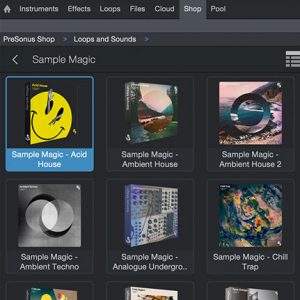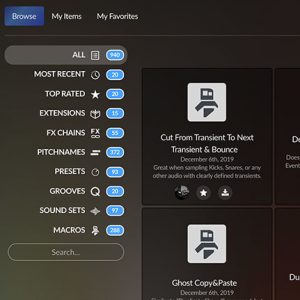Studio One 4.6—what’s new
Studio One 4.6 is here! To get it, launch Studio One and click “check for updates” from the “help” drop-down menu.
What’s new in 4.6
We’ve responded to the typical Studio One user requests in typical PreSonus fashion: by giving you what you’re hungry for with a side dish of stuff you didn’t even know you wanted. The new and dramatically improved Ampire leads the 4.6 charge, followed by substantial updates to Studio One’s Browser and major improvements to the Pattern Editor. We’ve also completely re-invented Exchange! (Remember Exchange? If you don’t, we aren’t mad.) And of course, there’s a smattering of uncategorizable improvements that we think you’ll like.
Oh, and if you’ve got Studio One 4, this stuff is all free. Read on.
The Ampire Strikes Back

Studio One’s guitar amp simulator, Ampire, has undergone more than a re-design—it’s been thoroughly re-engineered. We scoured auction sites and shadowy pawnshops to collect five of the most sought-after amps—responsible for a million hit songs—and the boys in Hamburg employed our State Space Modeling technology to emulate their circuit behavior down to the last freakin’ capacitor. That’s the same tech that led to the creation of our incredibly true-to-analog Fat Channel plug-ins, BTW. Oh, and we also modeled five additional classic stompboxes, and created five new cabinet impulse responses for a total of sixteen classic cabinets.
Furthermore, Ampire’s Pedalboard can be run as a standalone effect plug-in for folks who don’t need amp and cabinet simulation. Synth users should find experimenting with Pedalboard to be quite rewarding.
Studio One has always rocked… but it’s never quite rocked this hard.
Window shopping

Studio One’s Browser has received a major facelift. Most significantly, shop.presonus.com now has its own tab within the browser, so you don’t even need to leave Studio One to get new sounds and plug-ins when inspiration strikes. Navigating the Browser is also now significantly faster thanks to the new navigation bar below the tabs area. You also get a beautiful new Gallery view for exploring content in a more visible way—which works for the shop, your Instruments and Effects, SoundCloud, and Exchange.
Yeah, Exchange. Remember Exchange? Good, because here comes…
Exchange 2.0!

The new Exchange is where Studio One users can browse, download, review, and preview shared Studio One content from our unparalleled user community. In addition, you’ll be able to upload and rate content from other users. Furthermore, you get a public landing page where your content contributions are posted for all to see. Join the community and share liberally—everybody wins.
Pattern and Arranger updates
We introduced the Pattern Editor in Studio One 4, and we’ve already received a lot of feedback on how to make them better. You can now convert Instrument Parts to Patterns; both Melodic and Drum Patterns now allow for varied individual note lengths of more than one step. Great for basslines. Furthermore, each step in a Pattern can now have an individual delay value, which may be applied to all steps of an instrument at the same time.

Patterns now have their own Preset format, which includes Variations, which can be loaded and saved independently of the current instrument. And we’ve improved real-time recording to Patterns. (Try it, ATOM users. Seriously.)
Arranger tracks have received improved support for enclosed tempo and time signature changes, even when using the clipboard.
The kitchen sink
Podcasters and voice-over producers will appreciate the new Podcast Production template we’ve added to Studio One—but we didn’t stop there. We also added a new Macro Toolbar page featuring Macros and commands tailored to the specific needs of Podcasters and audiobook producers.
We also added some convenient new keyboard shortcuts, updated the Japanese, German, Spanish, and French manuals, and improved tempo-matching for loops, new gallery views for browsing Fat Channel EQs and compressors, realtime time-stretching support for Presence XT Editor… Click here for the release notes.
